Here is what the pickup plate looks like.
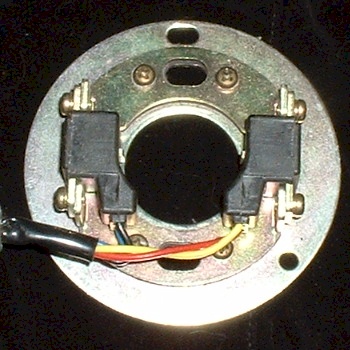
The pickups are attached with steel screws, and the magnet assembly is held to the timing plate with brass screws. If steel screws are used to hold the magnet assembly, the magnetism available to the pickups will be reduced.

When the pickup coils are removed, the magnets are exposed underneath them.
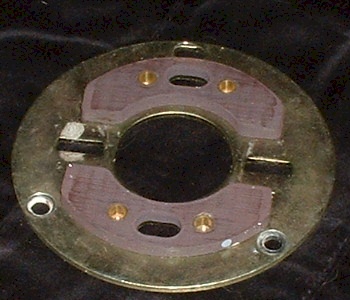
Some magnets have brass spacers pressed in and some don't. Usually each magnet will have a stripe or dot marking on one side. However, the marking are not necessarily consistent with respect to north pole and south pole. Sometimes it's the north that is marked, and sometimes it's the south that is marked.

The magnet polarity affects the signal polarity and magnitude, so they must be installed correctly. The magnetic north side of the magnets should face the timing plate, and the magnetic south side of the magnets should face away from the timing plate. Without a reference magnet to compare to, there is no way to know what face is north and what face is south, other than comparing the scuff marks or impressions on the magnets if there are any. Some magnets are hard ceramic and won't necessarily show any marks.
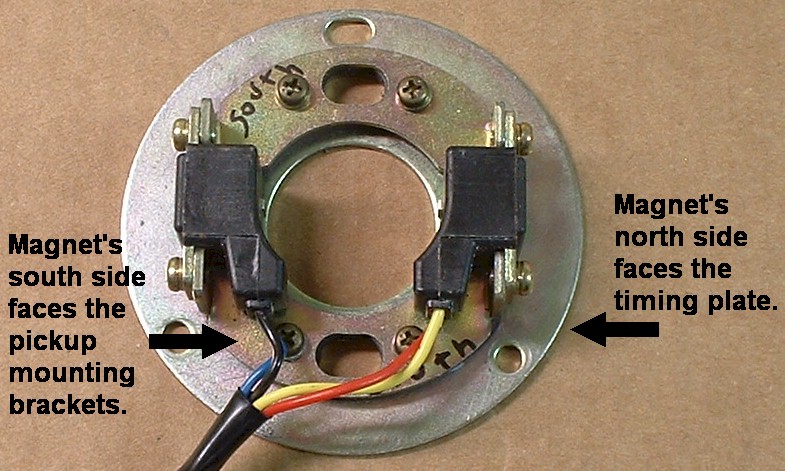
There is a way to determine the north and south poles of a magnet. (See the notes at the end of this page.) However, the best way to tell if it's right is to compare the output signals of the pickups using a voltmeter ( this can even be done while it is installed on the bike). First, find which way the magnets repel each other when they are flat against each other. Usually this will be when they are stripe-to-stripe or blank-to-blank, but that may not always be true. Then mount them to the plate so that the faces that repel are both facing the same way. Before mounting, it may be necessary to clean the magnets of any ferrous metal debris. A simple piece of masking tape works well to pull the filings off of the magnets.
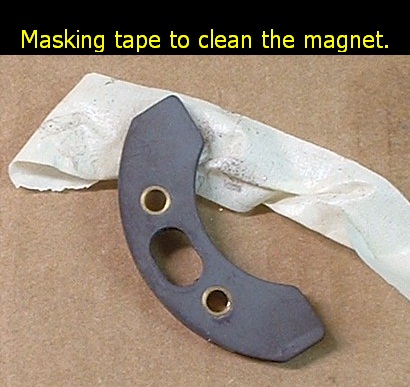
Checking Polarity:
To determine if the magnets are installed with the correct polarity a simple voltmeter test can be done.
Connect the voltmeter so that the red meter lead is connected to the black pickup wire, and connect the black meter lead to the blue pickup wire.
Now place a screwdriver tip near the center of the black/blue pickup center.
As the screwdriver moves toward the pickup, the voltage should be positive.
As the screwdriver moves away from the pickup, the voltage should be negative.
When the screwdriver stops, the voltage will return to 0v.
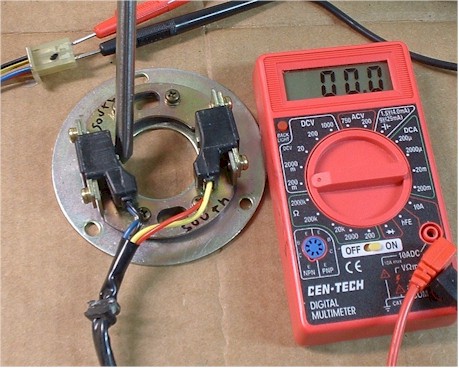
To check the other set of pickups:
Connect the voltmeter so that the red meter lead is connected to the yellow pickup wire, and connect the black meter lead to the red pickup wire.
Now place a screwdriver tip near the center of the yellow/red pickup center.
As the screwdriver moves toward the pickup, the voltage should be positive.
As the screwdriver moves away from the pickup, the voltage should be negative.
When the screwdriver stops, the voltage will return to 0v.
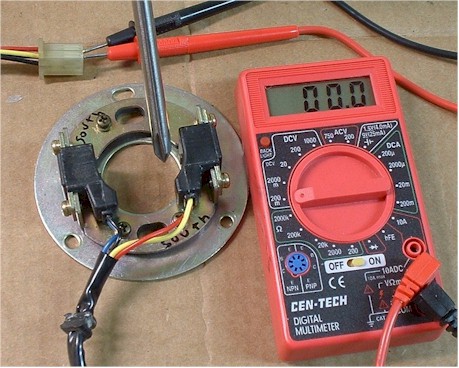
If both magnets are reversed, the polarity of the pickup signals gets reversed. If one is up and one is down, they cancel each other out, partially, and the signal becomes weak and possibly reversed, depending on which magnet is stronger. If one or both magnets get reversed, the bike may still actually start, but the timing will be off and the bike will not run correctly.
And since we're on the subject of getting polarity correct, here's the kz550 rotor. The rotor can go on two ways. There is a notch on the back side of the advancer that mates with the roll pin in the crankshaft. When the roll pin (and notch) are at the top position, pistons 1 and 4 are near top dead center, and the point of the rotor should point to the left, (or point to the rear of the bike), as you look at it mounted in the motor.
If the bike was running with the rotor pointing the other way (180-degrees-out), then some wires must have also been swapped.
On the smaller fours 550/650/750, the left-hand pickup (aka rear pickup) with blue(-) and black(+) wires, fires the right-side ignition coil which has a black wire to it. This coil fires cylinders 1 and 4.
The right-hand pickup (aka front pickup) with red(-) and yellow(+) wires, fires the left-side ignition coil which has a green wire to it. This coil fires cylinders 2 and 3.
On the larger fours 900/1000/1100, the left-hand pickup (aka rear pickup) with blue(-) and black(+) wires, fires the left-side ignition coil which has a black wire to it. This coil fires cylinders 1 and 4.
The right-hand pickup (aka front pickup) with red(-) and yellow(+) wires, fires the right-side ignition coil which has a green wire to it. This coil fires cylinders 2 and 3.
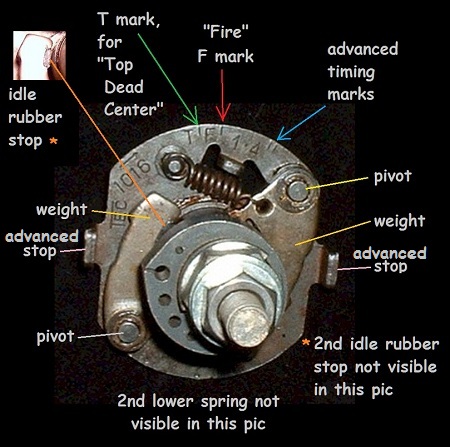
One last word of caution on the subject of ignition rotors: If you look very closely at the advancer arms, you will notice a tiny rubber pad attached to it. In the photo it is indicated as the "idle rubber stop". Make sure both arms have those rubber pads. Without them, the ignition advance will have too many degrees of movement. If the timing is set using idle, then full advance will be too advanced. This may cause damage to the engine under certain circumstances.
Determining Magnet Poles
If you have a magnet, but don't know which end or face is which pole, it can be determined with a simple electromagnet.
A magnetic field is also known as a "B field". The B field has a direction or polarity to it. The positive direction of a B field is defined as coming out of the north pole of a magnet, and going into the south pole of a magnet. However, inside the magnet itself, the B field continues from the south pole to the north pole. In this way, the B field actually creates a complete loop. (The B field doesn't move, the arrows are just to show direction orientation.)
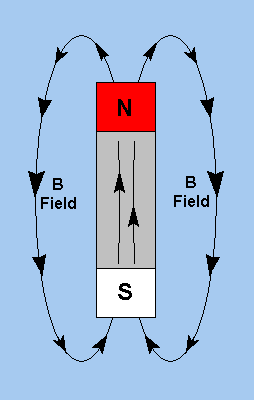
The direction of the B field in a permanent magnet can't be determined without using another known magnet. One known magnet is the Earth. Suspending a magnet will cause it to line up such that the north pole of the magnet points to geographical north. This is because the Earth's geographic north is actually magnetic south and vice versa, and opposite magnetic poles attract. As a permanent magnet, a big "S" would be on Alaska, and a big "N" would be on Antarctica. However, this is not a very reliable method since nearby metal or nearby B fields will affect the movement and could cause an errant result.
A better method is to use an electromagnet. Because of the way the magnetism is generated, a simple electromagnetic coil will always have consistent north and south poles. By knowing the direction of the current in the coil, the north and south poles are determined using the right hand rule.
RIGHT-HAND RULE : If the coil is grasped by the right hand so that the fingers point in the direction of positive current, the thumb will be at the end that behaves as a north magnetic pole. The opposite end (pinky end) behaves as a south magnetic pole. If the thumb is held out in a "thumbs up" manner, the thumb points in the direction of the B field.
Note: Positive current flow is opposite of electron flow. Positive current flows out of the positive terminal of a battery into a load, through the load, and back into the negative terminal of a battery. If one were to use the electron flow for the current, one would have to use the left-hand to have the thumb be at the north end. This is referred to as the "left-hand" rule.
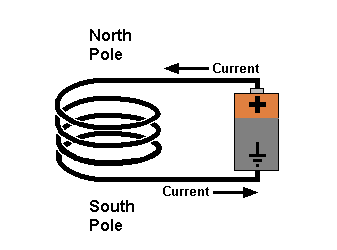
You can use the electromagnet to determine the poles of a permanent magnet which can then be used as a reference. Determine other magnet's poles using the electromagnet and the following: N repels N, S repels S, N attracts S, S attracts N.
Here is the one I use. It has an aluminum core so there will be no magnetism until there is a current.
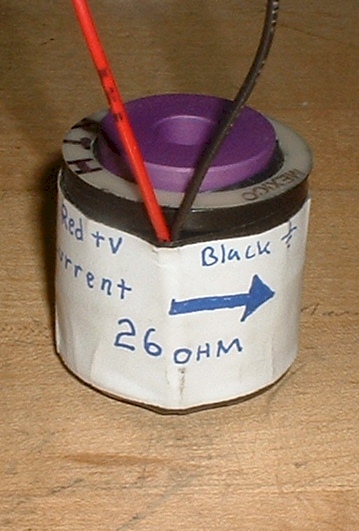
I use it to determine the poles on some random refrigerator magnets, then use those magnets as handy reference magnets.

Notes on generic magnetic pickups
These are some extra notes about pickups.With a pickup, such at these, where a permanent magnetic field is located in the coil, the pickups will give a signal whenever a piece of steel, or a magnet, approaches or moves away from the pickup pole. When a piece of steel is near the pickup pole, the nearest surface of the steel becomes magnetized and has the opposite polarity of that of the pickup pole. If the pickup pole is north, the piece of steel becomes south, and vice versa.
Here are some permutations of examples:
If the pickup pole is north, and the pickup produces a positive signal when steel approaches:
Produces negative signal when steel recedes.
Produces positive signal when a south magnet approaches.
Produces negative signal when a south magnet recedes.
Produces negative signal when a north magnet approaches.
Produces positive signal when a north magnet recedes.
If the pickup pole is north, and the pickup produces a negative signal when steel approaches:
Produces positive signal when steel recedes.
Produces negative signal when a south magnet approaches.
Produces positive signal when a south magnet recedes.
Produces positive signal when a north magnet approaches.
Produces negative signal when a north magnet recedes.
If the pickup pole is south, and the pickup produces a positive signal when steel approaches:
Produces negative signal when steel recedes.
Produces positive signal when a north magnet approaches.
Produces negative signal when a north magnet recedes.
Produces negative signal when a south magnet approaches.
Produces positive signal when a south magnet recedes.
If the pickup pole is south, and the pickup produces a negative signal when steel approaches:
Produces positive signal when steel recedes.
Produces negative signal when a north magnet approaches.
Produces positive signal when a north magnet recedes.
Produces positive signal when a south magnet approaches.
Produces negative signal when a south magnet recedes.
(Incidentally, these notes apply to guitar pickups as well.)